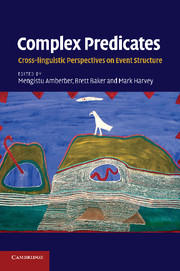Book contents
- Frontmatter
- Contents
- List of figures and tables
- List of contributors
- Preface
- 1 Introduction: complex predicates
- 2 Complex predicate formation
- 3 The light verb jungle: still hacking away
- 4 Events and serial verb constructions
- 5 Cotemporal serial verb constructions in White Hmong
- 6 Activity incorporates in some Athabaskan languages
- 7 Warlpiri verbs of change and causation: the thematic core
- 8 Complex predicates in Wambaya: detaching predicate composition from syntactic structure
- 9 Compound verbs and ideophones in Wolaitta revisited
- 10 The structure of the light verb construction in Amharic
- Index
5 - Cotemporal serial verb constructions in White Hmong
Published online by Cambridge University Press: 07 May 2010
- Frontmatter
- Contents
- List of figures and tables
- List of contributors
- Preface
- 1 Introduction: complex predicates
- 2 Complex predicate formation
- 3 The light verb jungle: still hacking away
- 4 Events and serial verb constructions
- 5 Cotemporal serial verb constructions in White Hmong
- 6 Activity incorporates in some Athabaskan languages
- 7 Warlpiri verbs of change and causation: the thematic core
- 8 Complex predicates in Wambaya: detaching predicate composition from syntactic structure
- 9 Compound verbs and ideophones in Wolaitta revisited
- 10 The structure of the light verb construction in Amharic
- Index
Summary
Introduction
White Hmong is minority language spoken in Mainland Southeast Asia, belonging to the Miao-Yao language family. It is an analytic, isolating language, and generally monosyllabic, with some multi-syllabic words due to compounding and borrowing. Syllable structure is predominantly CV, with each syllable bearing one of seven phonemic tones, represented in the Romanised orthography by a syllable-fi nal consonant letter. The order of core constituents is generally AVO for transitive clauses and SV for intransitive clauses. Constituent order codes the syntactic function of core arguments. Topical elements can be fronted and noun phrases that are recoverable from the context are often omitted. Head modifier order is predominant, with a few significant exceptions (for example, possessives precede nouns). Nouns are not marked for number; they co-occur with noun classifiers that assist in signalling definiteness and specificity.
Like many other languages of the Southeast Asian region, Hmong is rich in complex predicates involving serial verb constructions (SVCs). As explained by Baker and Harvey (this volume), SVCs are monoclausal but multi-predicational. That is, they involve two or more distinct predicating morphemes, linked together in a single clause by virtue of the fact that they share one or more argument positions through coindexation.
SVCs are thus significantly different from merger constructions, also introduced in Chapter 2 and discussed extensively in this volume. According to Baker and Harvey's analysis (see also Wilson 1999), while both of these types of complex verb construction are monoclausal, merger constructions involve the fusion of the Lexical Conceptual Structure (LCS) of two predicates, resulting in a single LCS, and thus a single predicate.
- Type
- Chapter
- Information
- Complex PredicatesCross-linguistic Perspectives on Event Structure, pp. 110 - 134Publisher: Cambridge University PressPrint publication year: 2010
- 4
- Cited by



